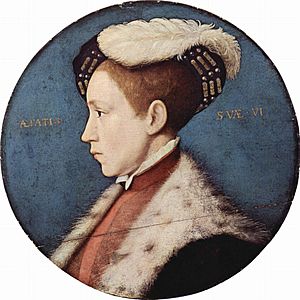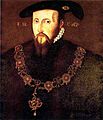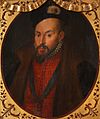Edward VI of England facts for kids
Quick facts for kids Edward VI |
|
|---|---|
| King of England and Ireland | |

Edward VI, by William Scrots, c. 1550
|
|
| Reign | 28 January 1547 – 6 July 1553 |
| Coronation | 20 February 1547 |
| Predecessor | Henry VIII |
| Successor | Lady Jane Grey or Mary I |
| Regent | Lord Somerset (1547–1549) Lord Northumberland (1549–1553) |
| Born | 12 October 1537 Hampton Court Palace, near London |
| Died | 6 July 1553 (aged 15) Palace of Placentia, Greenwich, near London |
| Burial | 9 August 1553 Henry VII Lady Chapel, Westminster Abbey |
| House | House of Tudor |
| Father | Henry VIII |
| Mother | Jane Seymour |
Edward VI (born 12 October 1537 – died 6 July 1553) was the King of England and Ireland. He ruled from January 28, 1547, until his death on July 6, 1553.
Edward was the only son of Henry VIII and his third wife, Jane Seymour. Sadly, his mother died just 12 days after he was born. He became king when he was only nine years old, after his father passed away.
Edward had two older half-sisters: Elizabeth, who was 13, and Mary, who was 31. Even though he was the youngest, Edward became king because he was male. Since he was so young, a group of important people called a Regency Council helped him rule the country. Edward died when he was 15 and a half years old. His cousin, Lady Jane Grey, was named as his successor.
Edward had two main advisers, also known as regents. The first was his uncle, Edward Seymour, Duke of Somerset. He was called the Lord Protector. For about two and a half years, Lord Somerset guided the young king. Later, John Dudley, Duke of Northumberland, took over as the main adviser. Both men wanted to make big changes to the Church of England.
Edward's time as king is mostly remembered for these religious changes. His father, Henry VIII, had already removed the Pope as the head of the Church in England. However, Henry VIII did not change much else about how the church worked. Most of the major changes to the Church of England happened during Edward's reign.
On July 6, 1553, Edward died at age 15, probably from a serious illness called tuberculosis. Before he died, he and his Council tried to decide who should be the next ruler. They wanted to stop the country from going back to Catholicism. Edward named his cousin, Lady Jane Grey, as his heir. He did not include his half-sisters, Mary and Elizabeth, in his plan. However, after his death, this decision was challenged. Mary became queen just 13 days later. Queen Mary I then reversed Edward's Protestant changes. But these changes later became the basis for the Elizabethan Religious Settlement in 1559.
Contents
Religious Changes During Edward's Reign
Laws were passed to make churches look much simpler. Before Edward, Catholic churches were often very colorful and decorated. Under Edward, things changed.
How Churches Changed
- stained glass windows and religious icons were taken out of churches.
- The furniture inside churches became very basic and plain.
Changes to Church Services
- The actual church services became simpler too.
- Ordinary people could now understand what was being said.
- Services, now called Holy Communion, were held in English instead of Latin.
- Archbishop Thomas Cranmer wrote the Book of Common Prayer also in English.
- Priests did not have to wear the bright clothes linked with the Catholic Church.
- Under Edward, priests were also allowed to marry.
- The king remained the Head of the Church.
All these changes were a big move away from the old traditions of the Catholic Church. In other parts of Europe, like Germany and Switzerland, religious groups had also broken away. They were protesting against the wealth and problems of the Catholic Church. These groups became known as Protestants. Under Edward, England became a Protestant country with its own independent Church of England.
Edward had never been a very healthy boy. His health got much worse in 1553. After Lady Jane Grey ruled for only nine days, his Catholic half-sister Mary became queen of England. The country then went through another period of religious changes.
Images for kids
-
Prince Edward in 1538, by Hans Holbein the Younger. He holds a golden rattle that looks like a sceptre.
-
Edward as Prince of Wales, 1546. He wears the Prince of Wales's feathers and crown on his pendant jewel.
-
The badge of Prince Edward, from a book by John Leland (1543).
-
Portrait of King Edward VI, aged about thirteen, by William Scrots.
-
Edward VI's uncle, Edward Seymour, Duke of Somerset, ruled England as Lord Protector from 1547 to 1549.
-
John Dudley, who led the Privy Council after Somerset.
-
Shilling with a portrait of Edward VI, made between 1551 and 1553.
-
Thomas Cranmer, Archbishop of Canterbury, greatly influenced Edward's Protestant beliefs.
-
In his "devise for the succession", Edward tried to make Lady Jane Grey his heir instead of his sisters.
-
Lady Jane Grey was announced as queen four days after Edward died.
-
Two weeks after Edward's death, the Privy Council declared his half-sister Queen Mary I as the new ruler.
-
A picture of Hugh Latimer preaching to King Edward and his courtiers.
See also
 In Spanish: Eduardo VI de Inglaterra para niños
In Spanish: Eduardo VI de Inglaterra para niños
















